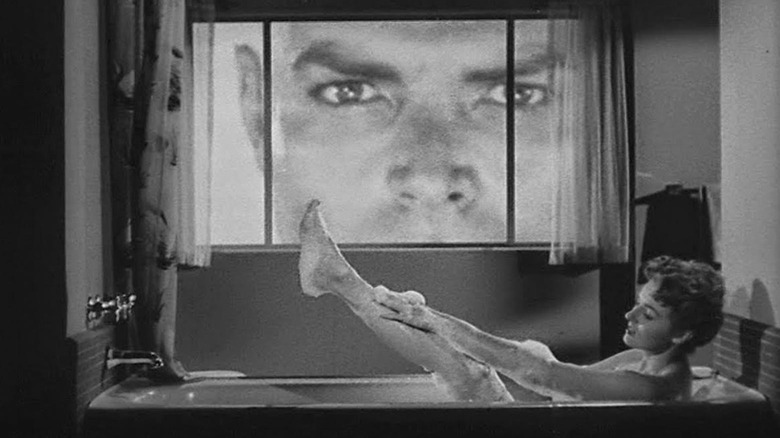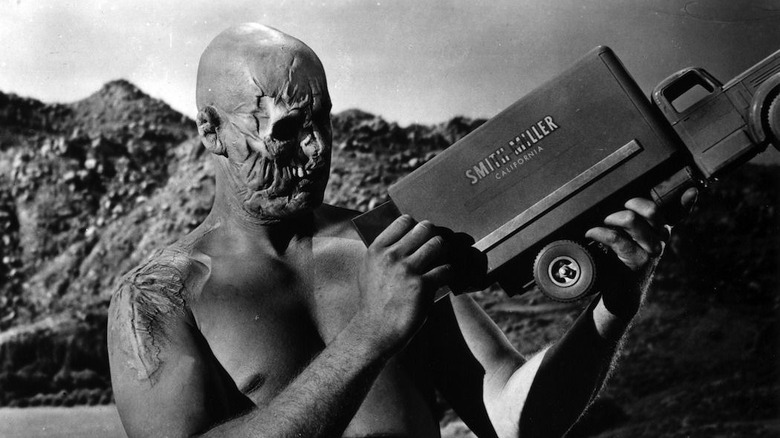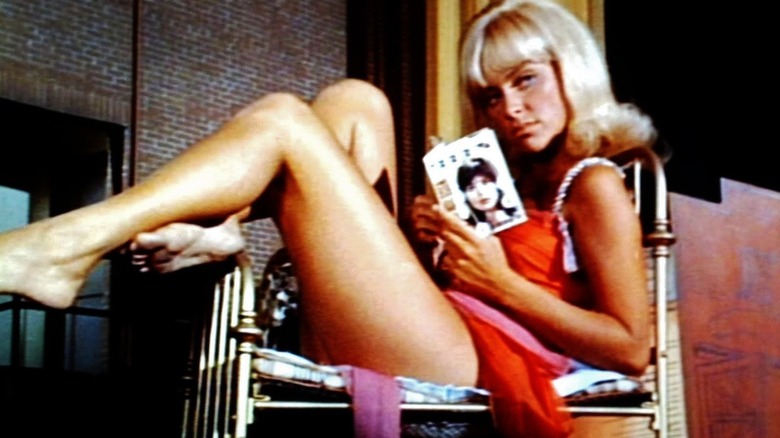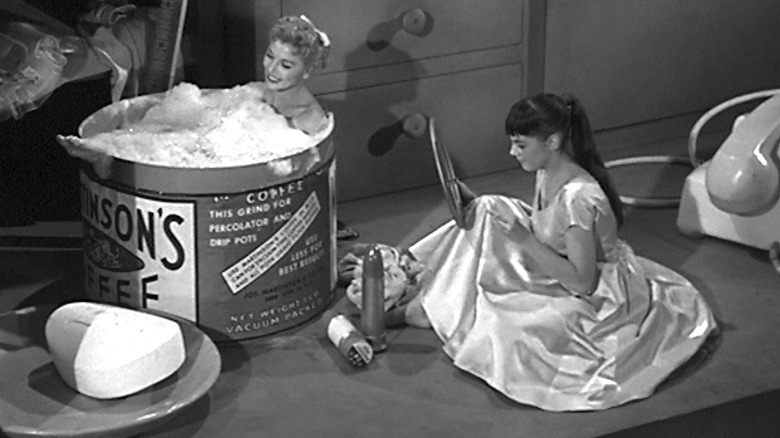Bert I. Gordon Was The Greatest B-Movie Filmmaker You Never Heard Of
As reported by the New York Times, on March 8, 2023, prolific B-movie filmmaker Bert I. Gordon passed away at his home in Los Angeles. He was 100 years old.
Bert I. Gordon is a name many may not be familiar with unless they were prone to visiting drive-in theaters in the 1950s, staying up late and watching monster movies on UHF TV in the 1980s, or were paying attention to "Mystery Science Theater 3000" in the 1990s. Gordon was the director behind such low-budget classics as 1955's "King Dinosaur," 1957's "The Amazing Colossal Man," its sequel from the next year, "War of the Colossal Beast," the 1965 outsized J.D. flick, "Village of the Giants," the 1976 H.G. Wells adaptation, "Food of the Gods," and the 1976 giant ant film "Empire of the Ants." One might note that all the films listed above involve giants of some stripe. One might also want to take note of Bert I. Gordon's initials.
Like many exploitation filmmakers of the 1950s, Gordon was dismissed in his heyday as a maker of cheap shlock and corny, effects-based monster pictures. He arose at a time when the Paramount Decrees were put into effect, which had banned motion picture studios from owning their own movie theaters. Independent filmmakers and ambitious low-budget studios like Roger Corman's American International Pictures were soon able to rush into the now-open cinemas, providing theater owners with a steady stream of cheap content. This was when filmmakers like Gordon, Phil Tucker ("Robot Monster"), Edward D. Wood, Jr. ("Plan 9 from Outer Space"), Ray Kellogg ("The Giant Gila Monster"), and Coleman Francis ("Red Zone Cuba") could thrive.
The late 1950s were a strange cinematic Wild West, and Gordon was one of its key gunslingers.
Glenn was 50 Feet Tall
Bert I. Gordon was born in Kenosha, Wisconsin, and, according to his obituary in Variety, took to shooting 16mm films as a youth. Early in his career, Gordon found that he could bring a camera very close to the local barnyard animals and, thanks to forced perspective and clever editing, make them look enormous. Mr. B.I.G., as famed horror fanatic Forrest J Ackerman called him, soon found a trademark that he was to use in many of his films. Gordon was positively preoccupied with the way a camera can skew perspective, and found whatever excuse he could to depict people growing.
"The Amazing Colossal Man," his 1957 classic that was a precursor to the Incredible Hulk, was about an army lieutenant named Glenn Manning (Glenn Langan) who was exposed to radiation from a nuclear explosion. The blast removed all his body hair and also caused him to begin growing to an incredible size. It also began robbing him of his ability to reason or communicate, and by the film's finale, Glenn is 50 feet tall and completely mindless.
What one might take from "Colossal Man" is its sad sense of utter tragedy. Glenn spends a great deal of the film trapped in a secret army tent, wearing only a demeaning diaper-like garment and wailing about his fate. For Glenn, this is a horror story, and he hates being a colossal man. "What sin," he weeps, "could a man commit in a single lifetime to deserve this?" Eventually, after Glenn naturally goes on a rampage, he is gunned down by the military and apparently killed. It's a tragic death to match that of Godzilla's or King Kong's. Each of them sad creatures unaware of their destructive power.
Getting B.I.G.ger
1958 was a banner year for Gordon. In addition to "War of the Colossal Beast" — which saw Glenn equally large, but now missing a chunk of his face and feasting on passing bread trucks — he made "Earth vs. the Spider" (more accurately, a dumpy New Mexico town vs. the Spider) and "Attack of the Puppet People," a knockoff of "The Incredible Shrinking Man."
Gordon's magnum opus, at least to this author's eye, may be "Village of the Giants," a colorful and energetic film about a group of wild, car-lovin' 1960s teens (led by Beau Bridges) who stumble into a Norman Rockwell-like town where the boy genius named Genius (Ron Howard) has developed a magical substance that makes livestock grow. The juvenile delinquent characters steal the substance, pass it around among themselves, and grow into 50-foot punks in bikinis. One might recognize the film's basso-profundo rock riff from its appearance in Quentin Tarantino's "Death Proof." "Village of the Giants" is a curious amalgam of J.D. scare films, beach party musicals, sci-fi monster movies, and weirdly wholesome Disney live-action family comedies of the era. Tommy Kirk stars and Toni Basil (who also choreographed) appears.
"Village of the Giants" was also made under Gordon's own studio, Berkeley Productions, and was meant to be the first of three contracted films. The other two were never made.
Throughout the 1970s and 1980s, many TV stations — wanting to round out an all-day schedule and lacking in original content — often paid a pittance to rock-bottom distributors for access to massive blocks of movies. Gordon's filmography worked its way into said blocks, and his pictures played regularly on late-night television. By the time his works appeared on "MST3K," he was already a known quantity for adventurers in late-night programming.
The MST3K years
Like "Manos: The Hands of Fate" or "Monster a Go-Go" before it, many of the films of Mr. B.I.G. wouldn't be known without being featured on "Mystery Science Theater 3000." Throughout that show's run, they watched "King Dinosaur," "The Amazing Colossal Man," "Earth vs. The Spider," "War of the Colossal Beast," "The Magic Sword," "Tormented," "Beginning of the End," and "Village of the Giants." "MST3K" liked to mock every cheap aspect of Gordon's filmmaking, once joking that the "I" in his name stands for "I am so ashamed." In fact, it was Ira.
Despite the cheapness of Gordon's film, there was clearly a passion lurking inside of them all. Like Wood, like Kellogg, and like Francis, Gordon was a true auteur, bringing his panache for low-budget special effects and his preoccupation with cinematic forced perspective into almost all of his movies. He also often bothered to zero in on the pathos of his characters, allowing them to absorb the extraordinariness of their situation. Gordon didn't bother to operate from the ethos of "cool," wherein the characters were too laid back to feel awe.
And while Gordon's films were often too cheap to capture any real sense of awe, the cheapness gave a weirdly earnest, gosh-darn sense of wide-eyed innocence to his monster movies. Gordon continued to make films for decades, making "Satan's Princess" as recently as 1990. He also returned for one last feature in 2014 called "Secrets of a Psychopath." Even into his 80s, he loved shlock and devoted his heart to it. Gordon was 100 at the time of his death, having left behind a grindhouse body of work that will be drifting through the margins of the pop consciousness in perpetuity.
R.I.P., Mr. B.I.G. Forever colossal in our hearts.



